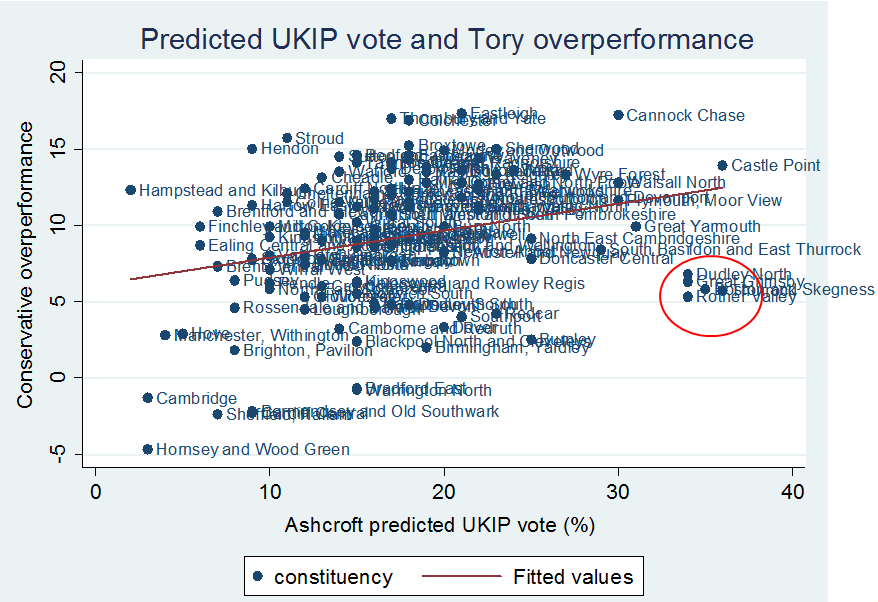 Most newspapers concluded that the Tories mainly won over Lib Dem and Labour waverers to score a surprising majority in the general election. However, as Eric Kaufmann shows here, it was really the English nationalist penumbra around UKIP, rather than Lib Dem or Labour switchers, that explains the great polling calamity.
Most newspapers concluded that the Tories mainly won over Lib Dem and Labour waverers to score a surprising majority in the general election. However, as Eric Kaufmann shows here, it was really the English nationalist penumbra around UKIP, rather than Lib Dem or Labour switchers, that explains the great polling calamity.
Like most who watched the election, I was stunned by the exit polls released at ten o’clock in the evening after polls closed. Former Lib Dem leader Paddy Ashdown told the BBC’s Andrew Neil that he would eat his hat if the picture they painted – of Tory victory and Lib Dem collapse – proved correct.
We now know it was, but the reason remains a mystery. Are there any clues? Yes, and the smoking gun points at UKIP. Or rather the ‘shy’ English nationalists whose pulse is reflected in local UKIP voting, but whose numbers extend well beyond it. As academic surveys such as the British Election Study (BES) and Understanding Society (UKHLS) reveal, both UKIP supporters and non-voters are overrepresented among those who refuse to answer questions about income or class on surveys, are dissatisfied with their neighbours and their lives, and are less trusting of others. It shouldn’t surprise us that these people are less likely to answer a poll.
In short, there is a silent minority of English nationalists whom UKIP draws upon. The Tories managed to scare enough of them away from non-voting and UKIP to win while convincing a small but important group of voters from other parties.
This isn’t the story that made the papers, however. Most focused on the Lib Dem collapse and Labour’s poor showing, concluding the Tories mainly won over Lib Dem and Labour waverers. UKIP’s share, at almost 13 per cent, was close to that predicted by the polls, so the pollsters patted themselves on the back that they got that one right. The press suggested UKIP’s 120 second place finishes, over a third in Labour seats, indicated they hurt Labour more than the Tories. However, this flies in the face of large datasets such as the BES, UKHLS and Ashcroft constituency polls. As Geoff Evans and Jon Mellon, as well as myself, have argued, UKIP disproportionately hurts the Tories, not Labour, by grabbing part of the Tories’ English nationalist voting base.
How do I conclude that the English nationalist penumbra around UKIP, rather than Lib Dem or Labour switchers, explains the great polling calamity? Ashcroft constituency polls formed the bedrock of most election forecasts, so I compared them with actual results in 130 marginal seats to see where he went wrong and where he called things right. It turns out the Tory’s surprising performance diverged most from predictions in seats where UKIP was slated to succeed. The exceptions were six high profile UKIP targets where the polls were pretty accurate: Boston, Thanet South, Thurrock, Rother Valley, Dudley North and Great Grimsby.
Take a look at figure 1. The vertical axis represents the ‘surprise’ factor: the proportion by which the Tories exceeded Ashcroft’s expectations. The horizontal axis shows UKIP’s predicted vote share in Ashcroft constituency polls, a good measure of the strength of UKIP in a given constituency. Notice how, with the exception of the UKIP targets in the circle, the Tories were more likely to surprise the pollsters in UKIP-friendly seats. The dots cluster more tightly when we look at Tory overperformance as a percentage of predicted vote, but in both cases the results show a significant relationship. The share of the population without qualifications, or who identify as English not British, also predicts where the Tories exceeded expectations, but not nearly as sharply as predicted UKIP vote does.
This can’t be said for the association between Tory overperformance and the predicted Lib Dem, Conservative or Labour share: predictions were not systematically off-target in strong Lib Dem or Labour marginals. This casts doubt on the view that the Tories did best among Lib Dem or Labour floaters. The Lib Dem equivalent appears in figure 2. Notice the flat line and looseness of fit of points around the line. The story of election night was not that Lib Dems flocked to the Tories. If that were true we would see the biggest Tory surprise gains in the seats where the Lib Dems were predicted to be strongest. The same point holds for Labour.
It’s instructive to look at the two seats where UKIP won byelections in 2014: Clacton and Rochester & Strood. In Clacton, Douglas Carswell hung on to his seat with 44 per cent of the poll, but lost nearly 1,500 votes – and 15 points of vote share – compared to the 2014 by-election. All of his challengers increased their share against him: Labour by 61 per cent, the Lib Dems by 68 per cent and the Tories by 86 per cent. The same thing happened in Rochester. Conservative candidate Kelly Tolhurst increased her vote by almost 60 per cent to 23,000 while UKIP’s Mark Reckless lost almost 1,000 votes against his 2014 tally to come second, with 16,000. At the same time Labour increased its vote in Rochester by 55 per cent and the Lib Dems by a whopping 258 per cent. Turnout went up by around 8,000 between 2014 and 2015 in both seats, so we should have expected UKIP’s numbers to rise. Yet they alone lost votes. These are seats where the Tories gained at UKIP’s expense while leaving others more or less unscathed. This is because ‘hidden’ English nationalist nonvoters came out for the Tories while some English nationalist UKIP voters switched to Cameron – all in response to the SNP-Labour threat. In a different election such folk may have swelled the ranks of UKIP, floating Carswell to victory.
It’s often forgotten UKIP won the European election, with 27.5 per cent of ballots. The BES internet panel’s fourth wave, conducted in March 2015, showed that 56 percent of those who voted UKIP in the 2014 election intended to vote for Farage in the general election. This should have put UKIP on around 15-16 per cent, 3-4 points above where polls placed the party. On its own, a switch of 3-4 points from UKIP to the Tories is not enough to have swayed the election, but what if this was just the tip of the iceberg?
The phenomenon of the ‘shy’ Tory is much commented upon, but pundits have failed to notice the ranks of hidden English nationalists from whence they spring. The more uprooted and radical of this stripe turned to UKIP, but the more traditional among them may be inclined to stick with the habits of their family or locale. UKIP voters tend to live in rural, less educated communities which pollsters find harder to reach. If there is a hidden mass of English nationalist voters who waver between the Tories, UKIP and staying home, Nicola and Ed spooked them in Dave’s direction. This explains why the Tories surged most in UKIP-friendly areas except high-profile battlegrounds such as Thanet South or Rochester where the mobilisation of English nationalists had reached saturation point.
If the swiftly-announced independent enquiry into the polling industry wants to find some answers, it should forget about Lib Dem and Labour switchers and hurry over to UKIP country.
Note: This article gives the views of the author, and not the position of the British Politics and Policy blog, nor of the London School of Economics. Please read our comments policy before posting. Featured image credit: Jonathan Rolande CC BY 2.0
 Eric Kaufmann is Professor of Politics at Birkbeck College, University of London. His latest publication is a Demos report, freely available, entitled Changing Places: the White British response to ethnic change.
Eric Kaufmann is Professor of Politics at Birkbeck College, University of London. His latest publication is a Demos report, freely available, entitled Changing Places: the White British response to ethnic change.

